Abstract
A part of research in education is related to innovation. This means trying to create new approaches or teaching techniques to the object or process being taught. It has always being said that there is a gap between science/technology and arts/humanities. For this reason, this paper tries to show some examples of how to link and apply these branches of knowledge among them, as part of an innovative and creative teaching/learning process.
As lexis applies to all the disciplines, because all the objects and concepts need words to express their significations, the terms of study are coupled in Spanish/English pairs. This way, students can learn vocabulary through contrast, comparison and semantic connections which trace the evolution of meanings.
The complement of visuals and images helps capture the attention of students who can see the language class as a complete mosaic that links humanistic and technical knowledge. Both similarities and differences may act as a mental trigger to store vocabulary in the memory.
Keywords: teaching, learning, innovation, metaphor, metonymy.
Introduction
The UPM is deeply involved in teaching science and technology and its related disciplines. In the latest years, it is also devoted to innovation in teaching, as part of a world current which tries to enhance new developments in pedagogy and didactics.
In the past, these two subjects were considered as an exclusive task of thinkers and philosophers who questioned about the objectives of the teaching function. In contrast, nowadays, every teacher, despite his or her field of knowledge, must wonder about the procedures of application through which he or she transmits new notions to students. Summing up, in the past, a good or complete teacher was only worried about his or her own discipline.
Nowadays, the perspective has changed, improved and become more complex and sophisticated: a 21st century docent assignment involves knowing about teaching and not simply mastering his or her core discipline of teaching.
Another factor is the consideration of the importance of the equilibrium between these two subjects: logically, the core discipline notions (mathematics, physics, etc.) have a greater weight in the mind, knowledge and time of the teacher than the secondary discipline.
Most disciplines in a Polytechnic University are applied ones, but, in this context, it becomes obvious that there is a subject that is considered “the subject”, and, another, that is applied but is “invisible” or shown in a veiled way.
From this point of view, the second discipline, an oblique one, pedagogy, applies to the first, being this the core subject, and the second, the applied science. Teaching is, in consequence, a dual task, since the object being taught is different from the teaching itself, except in the case of pedagogues that teach to teach.
- Teaching: core discipline + pedagogy
- Teaching: pure science + applied science
- Teaching: science itself (visible) + oblique application (invisible or veiled)
The problem is that an expert is, mainly and in effect, an expert in the field in which he or she has been formed. This supposes a tendency to consider the applied discipline as an oblique one. But, every expert in any field must apply an oblique discipline to his daily work: i.e., a sales engineer must apply the best-selling techniques to his engineering knowledge. In other words, there is not a single job that is simply related to an only discipline.
That is why most of us, attendants to this congress, are teachers of whatever discipline, because all of us have two interrelating subjects in our docent task: pedagogy and the core subject. In principle, teaching applies to our core disciplines, but, many times we could wonder which one applies to the other: All of us are linked by the common bond of teaching, which makes us be a part of a docent team.
For the same reason, interdisciplinarity applies to all our subjects, because the connection is not only with pedagogy, but with many more disciplines. It is precisely linguistics the more interdisciplinary subject, because, differently from other matters, it relates to all fields. All the sciences need the aid of linguistics to baptize their concepts and formulations.
This implies that all the teachers need a third discipline when giving their classes: language. By this, we mean that the docent task does not only need isolated words and terms to define concepts, but also a convenient linguistic framework to convey knowledge with cohesion and coherence.
After the above thoughts about teaching and its implications, we could wonder what has happened for the coming up of this new trend about innovative teaching:
Has anything gone wrong in the past?. This question may be applied to both teaching and learning: if teaching has not been correct, then learning must have had the same consequent results, although when school-leavers really learn is when they begin working, because practical knowledge is experience.
A different answer could be that teaching has been satisfactory but students have not processed knowledge completely, since the acquisition of expertise fulfillment takes time to settle down. We could wonder if, perhaps, university studies are too theoretical and do not prepare students for their future working life.
However, and on the other hand, students learn to manage when they begin working: one learns to provide work and workable knowledge when one begins working, not before, because university is simply a preparation for the future road to work and not work itself for the students.
So, in relation to the much-claimed complaint of students saying they feel unprepared for work life when they finish their studies, needless to say they need begin working to learn about real development.
A third answer to the above question, the new trend in innovation in teaching, could be that it is now a simple fashionable trend in universities all around the world. A mere look at the web of any university proves that this is a real tendency, an object of study of thousands of research or didactic innovation groups. Fidalgo (4th March 2006) says that innovation is nothing else than an inexistent dream only dealt with in the academic environment.
The reasons to defend this opinion are that methodology, assessment and learning continue the same as in the past. Perhaps hundreds of university directives thought that too much effort had been devoted to pure and deep research in detriment of teaching, so that this branch needed to be highlighted and reinforced to have the importance it deserves.
It is obvious that the first task of university is teaching, but this must be accompanied of the second assignment: research. The latter is the one that makes the difference between university and secondary education, and, not only the profundity or hardness of the studies.
Any university teacher should make research a part of his daily duties because this is the alma mater that gives not only depth but also originality to his knowledge. That is to say, pure and real research, not teaching, is innovative per se. In consequence and since innovation is always a positive characteristic, an aspect that differs from other perspectives, this feature must also be transmitted to teaching.
However, some practices that are considered as a part of innovative teaching should be classified under a different heading: for instance, that is the case of the flipped classroom. On one hand, if we think of the concept, it should not refer to the classroom as a physical environment (the space factor here does not have any importance because it may not exist), but to the class, to the process of acquiring knowledge.
As education must take place not only in the classroom but also outside it, we think that the real world is the best place to teach students what surrounds them ). On the other, it really refers to learning, not to teaching, since what is truly flipped is the process of learning by students.
Back to the aspect of innovation, it seems to address that all old practices are wrong or at least have demonstrated to be not too good. This is a tremendously mistaken consideration: the transmission of classical, universal and perpetual knowledge under classical practices will continue forever. We should value the aspect of tradition as much as the aspect of innovation.
Innovation implies thinking about new routes to build a new and open-access type of learning (Calderón, 1999). Moreno (1995) thinks that teachers must be aware of the need to innovate, show interest for the matter and verify if the action may be useful in order to accept or refuse it.
This way, Schvarstein (2007) considers educational innovation as an effective disruption or perturbation, because any change has to address an improvement in goal attainment. Lucarelli and Malet (2010) think that innovation implies a break with what was carried out in the past, with practices that have proved not to be satisfying.
Innovation does not mean to innovate per se but merely to be updated in regard to knowledge and practices. A teacher does not need to be necessarily modern. Many would think that modern means to use technology in the classes continuously, but new technologies are not new any longer, but a part of everyday life and teaching. However, as Muñoz (2005) defends, informatic tools help analyze information in a complete way, so, for this reason, they are far-fetching instruments.
But, in some other cases, using technology continuously may sometimes take more time than classical practices. For example, solving exercises with a sheet of paper and a pencil is usually quicker than doing them with a computer. And a premise of teaching, the same as in everyday life, should be: time is gold. So, in regard to the concept of time, we should consider what type of teaching/learning is more effective.
However, we think that the potential of some computer tools is wonderful if we think about autonomous learning and review practices for students. Also, as Silva (30/9/2015) indicates, efficiency is in the root of innovation. For Silva (30/9/2015), to increase the speed in results is a show of educational quality which directly benefits the teaching/learning process.
If, as we had said in the above lines, innovation is a positive aspect of education, because it is differentiating, we should enquire into the good side of this difference. Our opinion is that we should enhance this factor when it is time-saving and fosters the teaching/learning process.
Here, we explicitly mention the word learning because this should be the target of innovative education. The reason for this is not being innovative per se in relation to teaching, but improving the results of the learning process. In this dual relation, the teaching is the cause and the learning is the consequence, so what matters is the last, the result, not the means to achieve the end.
Teaching: cause / Learning: consequence
Aim of innovative teaching: fostering of the learning process
That is to say, no matter how classical, updated or modern a teacher is, if the students attain good results: the aptitude of the teacher should be measured by results and not by the means he or she uses. From this, the consideration is that a teacher is qualified when the students understand his or her explanations, and, eventually, retain and hold back knowledge in their minds.
For this reason, the aim of the following lines relates to the study of a linguistic resource, the metaphor as a tool to develop mental techniques to understand and memorize the interrelation of scientific and humanistic concepts through an innovative and interdisciplinary approach to teaching vocabulary.
The reason for this is that to make students retain what they have learnt is the greater challenge a teacher has to face (http://www.edsys.in/8-innovative-ideas-make-teaching-methods-effective ).
Theoretical framework: the metaphor as a tool for innovative teaching
A linguistic resource to retain concepts and images in the memory is the metaphor. In consequence, the latter can be considered as a tool for innovative teaching. Technical languages use specific terms to provide accuracy and eliminate ambiguity from the communication in a concrete field.
As these languages constitute a subsystem they belong to the linguistic general system and to a specific epistemic community that shares knowledge. But this shared knowledge departs from the reality around us.
This implies we get the concept and, in consequence, also the denomination by means of a recycling resource of language. This method, known as polysemy, gives new meanings, based upon a common semantic trait, to already existing words. Also diversity of meanings may be caused by figurative language, such as the one we perceive in metaphors.
The field of metaphors is object of study of a lot of authors (Bowdle & Gentner, 2005: 193–216; Pragglejaz, 2007: 1-39; Ruiz de Mendoza & Pérez Hernández, 2011: 1–25; Ohkura, 2003: 56-63) and also the teaching of its acquisition (Batlle, 2014; Boers, 2014: 208-224; Cheikh-Kahmis, 2013; Ibarretxe-Antuñano & Valenzuela, 2012; and, Vidiella 2012) since it is the focus of cognitivism. Nobody may doubt about the conceptual force of metaphors, so they must be exploited in the classroom as a tool to optimize both linguistic and conceptual knowledge.
What is evident is that metaphors imply the semantic evolution of a morphology, which has implications on lexicography. This science never introduces a metaphor in the first entry of a dictionary because the first meanings are never figurative.
But cultural elements may potentiate or obstacle response to metaphors. Different languages perceive different realities because the translation process shows that Spanish and English do not behave always in the same way.
In consequence, what is a metaphor for one language is not necessarily another one in the other language. Also metaphors may change, since a language may pay attention to some factors that the other neglects.
This behavior is a show of different cultural mentalities, and, in consequence, of distinct linguistic uses. Nevertheless, the changing and global world in which we live is a unifying factor that makes us understand the reasons why in the other language they have chosen a different metaphor from ours, or simply a non-metaphor.
This implies a certain language, any language, puts the stress or pays more attention to some aspects that, for another, are secondary. Really, metaphors are similar to pictures which may be looked at and processed from different points of view.
Both similarities and differences in the approach to metaphors in different languages must be taken advantage of in the classroom to act as a deep conceptual portrait of how reality is captured from distinct perspectives: this procedure acts as an activator to develop cultural knowledge in students when they understand that an image, a concept hides cultural, historical or sociologial connotations.
Metaphors are used in everyday language and special languages (Lakoff & Johnson, 1980; Lakoff & Nuñez, 2000), because, according to Fauconnier (1999: 47-69), language is only a small part of an immense cognitive iceberg. This iceberg composes a mosaic which shows the realities of science and technology from a kaleidoscope, full of cultural connotations. These act as a mental activator to develop cultural interest in students, since language applies to all the sciences.
At the same time, the coining of new words, the creation of terms, may be looked at as a process in which some linguistic connotations are enhanced, whereas others are neglected because they are considered secondary.
The latter implies that, as approaches to reality may vary among languages, word-creation by means of metaphors is similar to painting a landscape in which an element represents the close-up, and, others, the background. Blockley (2005) says that engineers imagine their projects in their minds before putting them into words.
That stage is known as ideation. This explains the importance of metaphors and what came first, the idea, the concept, which, in a second stage, was coined in a word, in a specific term of science and technology.
Method
The aim of this paper is the study of a linguistic resource, the metaphor as a tool to develop creativity and mental techniques to understand and memorize the interrelation of concepts among several disciplines.
A part of research in education is related to innovation. This means trying to create new approaches or teaching techniques to the object or process being taught. It has always being said that there is a gap between science/technology and arts/humanities. For this reason, this paper tries to show some examples of how to link and relate different branches of knowledge.
As lexis applies to everything, because all the objects and concepts need significant to express their significations, the terms of study are coupled in contrastive pairs Spanish/English to show the comparison between both of them. This way, students can learn vocabulary through contrast, comparison and connections. Both similarities and differences may act as a mental trigger to store vocabulary in the memory.
The study has focused three war terms- bayoneta/bayonet, bazuca/bazooka and cañón/cannon -to show the type of historical, musical or cultural implications could make students preserve the meaning of these words in their mental reservoir.
Lexicography has shown to be a powerful tool to trace the development of the different meanings of the above mentioned terms. The comparison among the various meanings has given interesting clues about the semantic evolution of the words by means of the analysis of the meaning intersections. Also, the use of images has acted as a clarifying factor to trace semantic connections.
Results
Under this heading, we are going to study some examples of metaphorical terms: bayonet, bazooka and cannon. By means of the teaching of these concepts with the aid of illustrations, students can become aware of the historic evolution of meanings. Images are important in teaching because they help clarify and interrelate concepts, and, also, make the dual process of teaching and learning more attractive and far-fetching. Science and technology progress by the making of more sophisticated mechanisms in which the more recent has a common aspect with the primitive one.
At the same time, students realize that all realities of the world are interconnected and learn to share common knowledge in application to all the fields. This way, weapons have an influence on electricity through the sharing of similar devices.
Bayonet
According to the DR, in the first entry, a bayonet is “a daggerlike steel weapon that is attached to or at the muzzle of a gunand used for stabbing or slashing in hand-to-hand combat”, as we can see in Image 1. This image represents the real use of the word and a non-figurative meaning.

Image 1
From this non-figurative definition, the second entry (DR), a metaphorical deviation, comes out with the meaning of “a pin projecting from the side of an object, as the base of a flashbulb or camera lens, for securing the object in a bayonet socket”. The FD says a bayonet base is “a coupling mechanism for attaching removable lenses to the body of a camera, using a bayonet socket” (See Image 2).

Image 2
Bazooka
The denomination the DR offers is an Americanism that refers to a musical instrument, a home-made trombone, invented and played by the comedian Bob Burns in the 1930s and 1940s. So, this one is the non-metaphorical meaning of the word and the older one. We can see the instrument in Image 3:
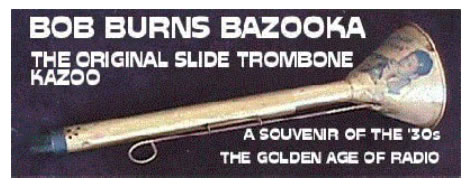
Image 3
However, according to the DR, a bazooka is “a tube-shaped, portable rocket launcher that fires a rocket capable of penetrating several inches of armor plate, as of a tank or other armored military vehicle”, as seen in Image 4:
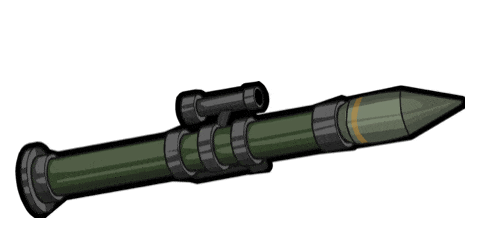
Image 4
Obviously the points in common between the two images are two: portability and a lengthy tube shape used either to produce sound or to rocket ammunition. The fields of reference have evolved from music to weapons.
But there is one more reference to the term bazooka, also used in the vocabulary of television. The Spanish adaptation is bazuca. It consists of a set of camera support tubes which can be fitted together to place a camera at the desired height, as seen in Image 5.

Image 5
Cannon
According to the CD, the historical meaning of the word cannon relates to “a heavy artillery piece consisting of a metal tube mounted on a carriage”, as seen in Image 6.
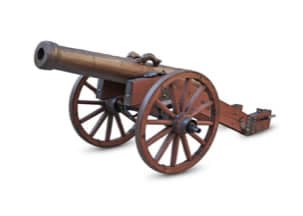
Image 6
But, in the third entry of the same dictionary (CD), it is defined as a tube or drum, and, from this, we understand the term may be related to two different shapes: a lengthy one, and, another, somehow more indefinite or vague. However, if we look at Image 7, the part that has the tube shape is the camera lens: that is the part that has given the name to the apparatus itself because it is precisely the cannon of light the part which projects images.
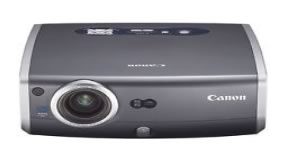
Image 7
A cannon always refers to objects, but, in the compound human cannon, as seen in the example by Joy Martin in The Image of Laura: “human cannon, Cassie shot across the foyer into the arms of a slight, fair-haired woman” a person is dehumanized by treating her as an object. In Spanish the same expression is used-esa mujer es un cañón/está cañón (that woman is a cannon).
These are examples of cosification, another case of figurative language which deviates reality by treating persons as objects. Also the expression cannon fodder in which men are regarded as expendable because they are part of a huge army (CD) dehumanizes persons since they are seen as food.
The equivalent expression is used in Spanish: ser carne de cañón. In contrast, the cannon is considered a living being that may eat. This implies that the cannon suffers a process of personification, since human features are applied to an object, in this case, the action of eating. This shows that different languages see concepts from parallel and coupled perspectives, although these visions are clearly distorted.
Finally, we may also find the compound human cannon, which in this case is not scornful. It refers simply to a process of metonymy that defines one thing in relation to the other by a simple nearness or contact. In image 8, we can see the contact between the person and the cannon, and, because of this, the person gets the name of the object. Nevertheless, it becomes clear from the picture that the person does not share the function of cannon, but merely as ammunition.
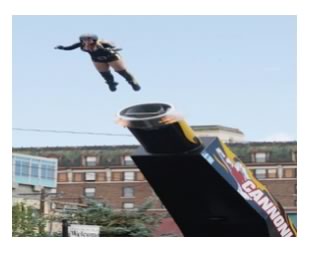
Image 8
Discussion
The terms of study, bayonet, bazooka and cannon have shown a total equivalence in their corresponding translations and in the use of total metaphorical correlation. From this, it is clear that Spanish takes loans from English because this is the universal language of science and technology.
The language which creates the object, the invention or mechanism, also coins the corresponding term. The only exception could be the term bayonet, a French voice, whose electronic use, however, has entered into Spanish through English. Table 1 shows the coupling of the terms in the correlation Spanish-English:
Spanish Term English Term Metaphor Equivalence

Table 1
The connection between the two meanings of the word bayonet lies in the attachment of a piece to another one by means of a metallic component. With this, we see how languages make use of the same similarities between objects to denominate the second with the name of the first concept.
Bayonet (weapon) / Bayonet (light bulb):
Semantic intersection: locking notches
In relation to the term bayonet, the translation into Spanish maintains the metaphor: casquillo de bayoneta, which is a reference to weapons. Although the word has a French origin, the relation with electronics has been introduced into Spanish through English.
In relation to the term bazooka, the similarity between the musical instrument, the weapon and the TV device lies both in the tube shape and portability. However, the meaning that has gained use is the one which relates to the definition the DR offers. This implies the evolution of the word has passed from the environment of music, to the field of war, TV and electronics. It is a loan that has penetrated in other languages because of the evocative power and sonority of the word itself.
Bazooka (musical instrument) / Bazooka (weapon) /Bazooka (tv device):
Semantic intersection: portability / tube shape
The word cannon has implications in the field of war and electronics. As time elapses, new objects recycle already-existing terms because it is an economic way of creation of meanings under an old morphology. In this case, the projector takes advantage of the significant related to war, to use it simply because of a mere shape similarity.
Cannon (weapon) / Cannon (projector):
Semantic intersection: tube shape
We can also see how the first field (war) has coined new concepts that have caused the use of certain figures of speech, such as cosifications (presenting human beings as objects: persons considered as cannons because of their attractive aspect of persons considered as food because they suffer a punishment without any reason) and metonymies (presenting something, persons in this case, with the object with which it is in contact).
Conclusions
In this paper, we have seen how language and metaphors interact with other disciplines, not just with pedagogy and linguistics, but also with science and technology and with other related humanistic disciplines. This way, the teaching process tries to be innovative, complex and creative.
At the same time, it gives a brief view of how the world around us is a rich melting point that links all types of knowledge and different disciplines. This perspective helps students relate different concepts and see the teaching of a particular subject as a net of interrelated content with other disciplines.
The study has focused three war terms such as bayoneta/bayonet, bazuca/bazooka and cañón/cannon to see what type of historical, musical or cultural implications could make students preserve the meaning of these words in their mental reservoir.
The group bayoneta/bayonet focuses on history because the object is perceived as an old weapon. The connection point between the old and new meaning lies in the attachment of pieces by a metallic component.
The pair bazuca/bazooka links the new, support tubes, with the old meaning, launcher, by means of two common concepts: tube shape and portability. Also, in this case, there is another influencing field, music, since bazooka was the name of a music instrument.
The word cañón/cannon refers to two different contrastive shapes: a lengthy or a rounded one to define the same war concept. On the other hand, both languages see the object as a personification when they consider that cannons can eat humans. At the same time, the term also may undergo a process of metonymy that transforms humans into cannons.
The complement of visuals and images helps capture the attention of students who can see the language class as a complete mosaic that links humanistic and technical knowledge. This approach to teaching tries to capture attention in a way that makes students not forget the contents of the class in their memory. Sometimes an image is more valid than a thousand words.
References
- A. Fidalgo, “La alegoría de la caverna de Platón y las tendencias en innovación educativa”, Barreras Innovación, https://innovacioneducativa.wordpress.com/, 4 marzo 2016.
- B. Bowdle and D. Gentner, “The career of metaphor”, Psychological Review no. 112, pp. 193–216, 2005.
- C. Okhura, “The semantics of metaphor in the Game Theoretic Semantics with at least two coordination equilibria”. LexFig ´03, Proceedings of the ACL Workshop on Lexicon and Figurative Language, no. 14, pp. 56-63, 2003.
- Collins Dictionary. Retrieved April 20 2016 from http://www.collinsdictionary.com
- D. Blockley, New Dictionary of Civil Engineering, London: Penguin, 2005.
- D. Silva, “Innovación en la práctica docente”, Vinculando, 2015. https://vinculando.org/educacion/innovacion-practica-docente.html
- Dictionary Reference. Retrieved January 2016 from http://dictionary.reference.com
- E. Lucarelli, and A. M. Malet, “Universidad y prácticas de innovación pedagógica”. Estudios de casos en la UNS, Buenos Aires: Jorge Baudino Ediciones, 2010.
- EDSYS. 8 Innovative Ideas to Make your Teaching Methods More Effective. http://www.edsys.in/8-innovative-ideas-make-teaching-methods-effective
- F. Boers, “Cognitive linguistic approaches to teaching vocabulary: assessment and integration”, Language Teaching no. 46, pp. 208-224, 2014.
- F. Cheikh-Kahmis, “Lingüística cognitiva aplicada a la enseñanza del léxico en segundas lenguas”, Las colocaciones en clase de ELE, Madrid: UNED, 2013.
- F. Ruíz de Mendoza and L. Pérez Hernández, “The contemporary theory of metaphor: Myths, developments and challenges”, Metaphor and Symbol no. 26, pp. 1–25, 2011.
- Free Dictionary. Retrieved April 15 2016 from http://encyclopedia2.thefreedictionary.com/
- G. Fauconnier, “Introduction to methods and generalizations”, in T. Janssen and G. Redeker, Scope and Foundations of Cognitive Linguistics, pp. 47-69. The Hague: Mouton De Gruyte, 1999. http://www.macmillandictionary.com/
- G. Lakoff and M. Johnson, Metaphors We Live By, Chicago: The University of Chicago Press, 1980.
- G. Lakoff and R. Núñez, Where Mathematics Comes From: How the Embodied Mind brings Mathematics into Being, New York: Basic Books, 2000.
- I.Ibarretxe-Antuñano and J. Valenzuela, Lingüística cognitiva. Barcelona: Anthropos, 2012.
- Innovation Unit. 10 Ideas for 21 Century Education.
- J. Batlle, “En el amor y en la guerra: una unidad didáctica para el desarrollo de la competencia metafórica”, Jornadas pedagógicas de ELE, Valencia: Educaspain, 2014.
- J. Calderón, “Innovación educativa”, Revista de Investigación Educativa, no. 1. 1999.
J. Martin, The Image of Laura. Diamond Books, 2015. - J. Muñoz, Analisis cualitativo de datos textuales con Atlas/ ti 5, Barcelona: Universidad Autónoma de Barcelona, 2005.
- L. Schavarstein, Diseño de organizaciones. Tensiones y paradojas, Buenos Aires: Editorial Paidós, 2007.
- M. G. Moreno, “Investigación e innovación educativa”. La tarea. Revista de Educación y Cultura no. 7, Guadalajara (México), pgs 21-25, diciembre 1995.
- M. Vidiella, “El enfoque léxico en los manuales de ELE”, Suplementos MarcoELE no. 14, 2012. http://marcoele.com/descargas/14/vidiella-lexico.pdf
- Pragglejaz Group, “MIP: A method for identifying metaphorically used words in discourse”, Metaphor and Symbol no. 22, pp. 1-39, 2007.
Abbreviations
- CD Collins Dictionary
- DR Dictionary Reference
- FD Free Dictionary
Images
- Image 1. Retrieved from Finnish Bayonets.
- Image 2. Retrieved from A Buyers Guide for LED Light Bulbs. http://www.slideshare.net/1000bulbs/buyers-guide-for-led-light-bulbs-by-1000-bulbscom
- Image 3. Retrieved from Bob Burns Bazooka. http://www.flamesofwar.com/hobby.aspx?art_id=833
- Image 4. Retrieved from Bazooka. http://cactusmccoy.wikia.com/wiki/Bazooka
- Image 5. Retrieved from Bazooka BTA8250D-DE BT Series 8-Inch 250-Watt Class D Double Ended Bass Tube en Amazon punto com
- Image 6. Retrieved from Cannon.
- Image 7. Retrieved from Canon Projectors. http://www.ebay.com/sch/Canon-Projectors/25321/bn_355494/i.html
- Image 8. Retrieved from Taco Cannon for the Win!.
- Authors: Verónica Vivanco, Ángel Javier Ramírez, Félix Escolano.
Datos para citar este artículo:
Verónica Vivanco,, Ángel Javier Ramírez,, Félix Escolano. (2017). Didactics of technical vocabulary: the influence of arts, humanities and culture. Revista Vinculando, 15(2). https://vinculando.org/en/didactics-of-technical-vocabulary-the-influence-of-arts-humanities-and-culture.html
Deja un comentario